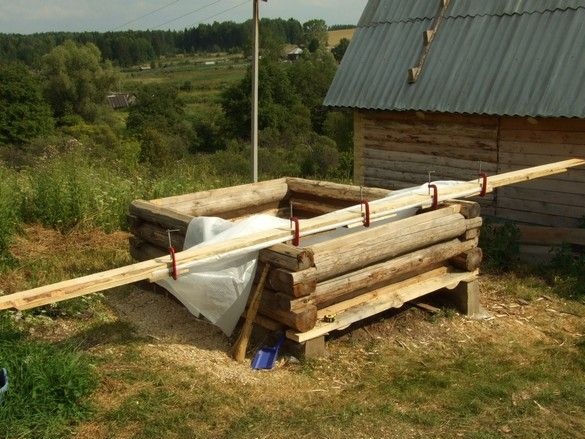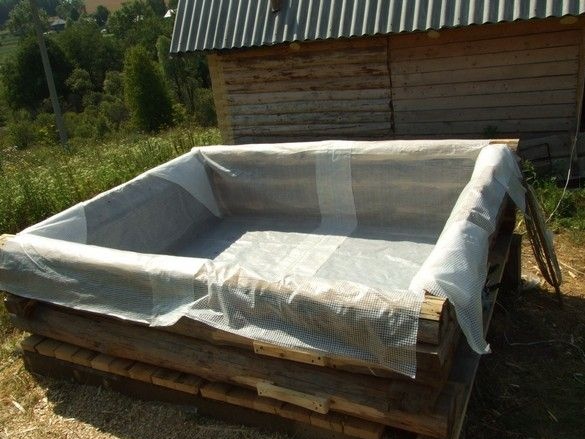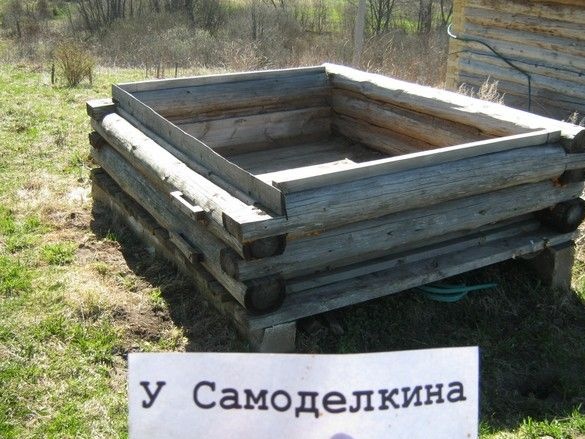
Hanging out in warm water on a sultry summer day is very pleasant, with a great hoot, jumping after a hot bath in cool water in spring or autumn is no less pleasant. About the children, I humbly shut up - in the summer, they can be removed from the water either by the promise of monstrous cars, or equally monstrous promises of any sort. Just wonder how their membranes between the fingers do not grow ...
The stationary pool, built in accordance with all the rules, is a solid structure, very complex and expensive, requiring a lot of special communications. The pool also requires a fair amount of attention - maintenance, equipment maintenance, change of consumables and chemicals. Probably not worth talking about the cost of such structures.
Ready-made "bowls" exist and are offered - sort of troughs of factory production, of different sizes and shapes. From plastics or even ceramics. At the same time, some of these molds are offered in sections, which apparently makes it much easier to transport to the future happy pool owner, especially with significant volumes of the vessel.
Yes, we can talk about a decorative pond, with water lilies, frogs and mosquitoes, as well as a purely bathing option - with rubber ducks, all sorts of inflatable stuff and special tanned young ladies with tots (in advertising pictures). Everyone laughs, including ducks, from happiness, presumably.
There are several more options for folding structures - a film inside the prefabricated frame and a film, the shape of the vessel for which is supported by inflatable elements. They cost differently, they differ in design and operation features, but in general, they are much cheaper and much shorter than stationary ones. There is such a pool on the ground, on an even area, often its plasticity is masked with different wooden scaffolds, so that it doesn’t look so alien among the greenery, well, it’s more convenient to climb in. Generally speaking, such a folding version of the pool is good for people who are not inclined to fuss with landscape design, endless improvements and cultivation of their site and other gazebo trellises-gabions. Relatively little fuss, not prohibitively expensive, does not require solid building structures, it is not difficult to dismantle.
Faced with the desirability of such a capacity on our site and we are a few warm seasons, we were not so hot in the Urals, a child ran to a girlfriend in her water-storage water tank, I had to compose a small improvised pool. In addition to bathing, a good capacity with water is also good in the sense of accumulation and heating of water. For irrigation - at the correct gardeners, water immediately from the well-well-spring - toveton. Well, save you Allah, from watering from a water supply system - plants from ice water, and even chlorinated, to put it mildly - are not thrilled. In addition, in a hot, dry summer, the water supply will not hurt in the fire sense.
The task was traditional - to do something cheaper, of course it is better from nothing, that is, as Owl said, for nothing. From the past material. By willful design decision, the fence is made of film, the frame is wooden. Categorically did not want to fence a voluminous structure of bars and boards with props, slopes, struts. I saw something like that, more, with fingers moving in the air, laconic. It was decided to make it, a fence, from thick logs - a sort of simplified log house. Just lay idle, conifers logs that were almost sharply sharpened by bugs, almost completely for nothing, lay on construction not fit in the stove too (lots of soot). And of these, I decided to isolate them.
What was used.
Instruments.
Classic trench tool kit. Garden car. For marking on the ground - ropes, tape measure, a long building level or a water level. Carpentry and carpentry tools, of course - a good ax on the arm. It is very good if there is a chainsaw or even better - a chain electric. Used a “furniture” stapler. A screwdriver, “Bulgarian”, “gun” for mounting foam came in handy. Tools for concrete work, including buckets, a trough for the preparation of concrete, water tanks.
Materials
In addition to the logs, were used - a board, mainly “inch” (2.5cm) and “floor” (50mm) thick. Ruberoid. Materials for the preparation of concrete. It is clear - nails, screws. Polyurethane foam, roll insulation.
The first thing I decided on the size of the pool. I wanted something like this, without fanaticism, without paths from cables with floats into the distance, and concrete pedestals for starting on the side. Something small and comfortable, so that at least fuss, but to plunge me (1.9m) reclining, at least diagonally, it was possible. Well, the depth - so that it’s not like the Mariana Trench, but it was possible to leave a child unattended for a long time. In a word, having tried on this way and that, thoughtfully resembling a tape measure, the internal dimensions, “clean”, are accepted - 220x170x60cm. Recommended for execution - during the construction process small deviations are quite acceptable, we are not building a nuclear reactor.
Further, I decided on the place - an important, you know, business. To have more sun and less wind, not far from the bathhouse, from home, if possible, too. Yes, it would be nice, even a little above the garden - to drain the water by gravity, warm and cloudy. The place was chosen, despite the fact that it is on the north side of the bath, most of the day in the summer, the high sun illuminates it perfectly. The water supply, again, is nearby. A vegetable garden and many bushes-trees below, a house (fire function) is nearby.
To simplify the design and speed up the construction, he put a fence right on the ground, adding sand, in an attempt to compensate for the slight slope. I took advantage of the season, but a slight bias in the case of the pool is very unpleasant - the water is in one corner, and indeed, it’s all crooked ... Look, my heart is out of place. In a word, the next season I undertook to redo the capacity a little more thoroughly, with a foundation.
The foundation was made in the form of two small "stripes" with a width of about 20 ... 25 cm.
First of all, marking was carried out - the axes of the foundation were marked on the ground. Narrow trenches were dug, to a depth of about two bayonet shovels or a little more, the vegetation layer was removed and buried a little in the ground. The width of the trench is also the width of the shovel.After aligning the walls and the bottom, backfilling was made of sand - in thin layers, with wetting from the watering can and ramming with a trimmed log with a horizontal handle.
After bringing the sand backfill to the desired level of the trench and leveling it, the bottom and walls of the trench were lined with plastic wrap. Here I used any pieces of the film, no matter how significant the size is - its task (the film) is to prevent the absorption of water by dry walls and the sandy bottom of concrete until it hardens. At the bottom, the film can be crushed with stones, fragments of bricks, pieces of iron, a boot, the upper edges, so as not to turn up in the wind, were fastened with the same bricks, with large nails - stuck them through the film into the ground.
Due to the modest size and low strategic value of the structure, reinforcement was not used - saved. In small portions, preparing concrete, gradually flooded both trenches flush with the upper edge of the earth. After pouring concrete, you need to take some time to preserve moisture - cover it with a film or roofing material, or compensate for the loss of water several times a day, pouring concrete from a watering can. The procedures should be performed during the initial set of concrete strength - about a week, well, if - “Hold on there is no more strength”, then three or four days, but carry out the following operations carefully so as not to ruin anything.
The upper, aboveground parts of the foundation were also cast from concrete. For their casting, a pair of shields were made from scraps of boards trimmed with ruberoid on the working side. In order not to dirty the extra boards, the formwork alone, after casting one support, was moved to another place. When installing the formwork, the boards were fastened with scraps of boards, propped up with struts, pegs hammered into the ground. The slots were sealed with improvised means. Yes, the important point is that it is more correct to prepare concrete not with liquid, but with such a consistency at which it has to be laid in the mold. It’s a bit whiter than labor-consuming, but you can save a lot of money on formwork (they do not go so far apart) and the concrete comes out more durable - sand does not settle in it as in the liquid version.
After the final hardening of concrete, the construction site was cleared of rubbish, and proceeded to assemble the wooden part. The bottom was made up of not the best pieces of a thick “floor” (50mm) board laid on (between) concrete supports. He fastened the makeshift shield from below with several boards so as not to disperse. Understood, of course, roofing material for waterproofing. On top of the folded dismantled felling fence. Oh - Tse Dilo! Not that the previous rickety squalor. Everything is even and noticeably more thorough. Yes, the log house folded, making flat “paws” so that the logs touched along the length. In the paws and drilled nests for dowels. Flat paws allowed the logs not to swing on top of each other and used a short drill to drill the nest holes.
They cut the daggers themselves on a circular saw from coniferous woods, because to stand them without a roof on the street, calibrated blocks were obtained, then, with a small hatchet, he squeezed the corners to them.


I covered the hollows between the logs with clay mixed with shavings - so that the film is not pressed too hard into the pits with water. He closed up large openings with bars and two boards. The film was used inexpensive - reinforced, all in a kind of squares. Unfortunately, it was offered for sale of insufficient width, had to be glued from two panels. It is this process that is captured in the photo above - with long boards and clamps. Before laying the film, a soft layer was organized at the bottom of the pool - an elastic insulation 5 mm thick to avoid damage from small unnoticed pebbles and other debris.

The applied film is not too durable - it has withstood the season, but in the end several leaks formed.The next time we bought a special film for pools, it is much thicker and more elastic. But also much more expensive. By that time, an unlimited spring had been made, which often allowed changing the water - muddy and warm for watering the bushes, and pumping new ones. By the way, in order for the water to be longer transparent, the amount of garbage brought into the pool should be minimized. And most of all, it is brought in by little ones hustling here and there. It is convenient to put a “small” flat container of water “at the entrance” so that they pass through it. ¾ garbage will remain at the entrance.
In our country, near the pool, a natural focus was formed for heating water. We burn substandard, coniferous remnants there that you can’t put into a decent furnace. We warm water for nightly washing off of dust in a cool season. So, if you thoroughly heat the whole barrel, you could even splash around for two or three hours with pleasure in a cool, sunless time. Then the water cooled.


Until recently, until there was a greenhouse, in the spring they used the pool as a miniature greenhouse for growing seedlings. It was covered on top with two frames with a translucent non-woven material. At the same time, much more light came into the plants than on the windowsills, even with additional lighting.

